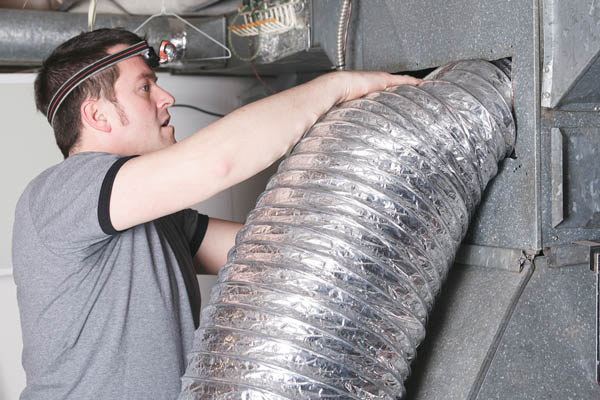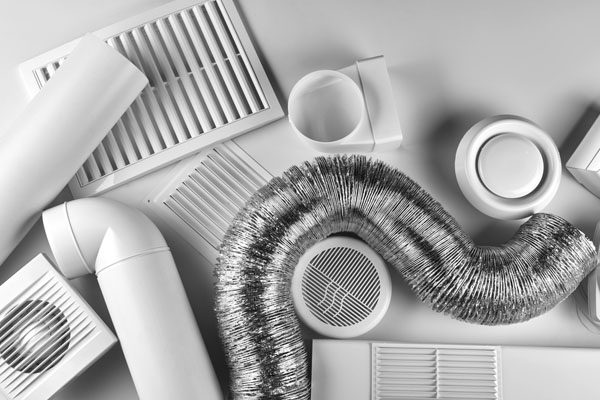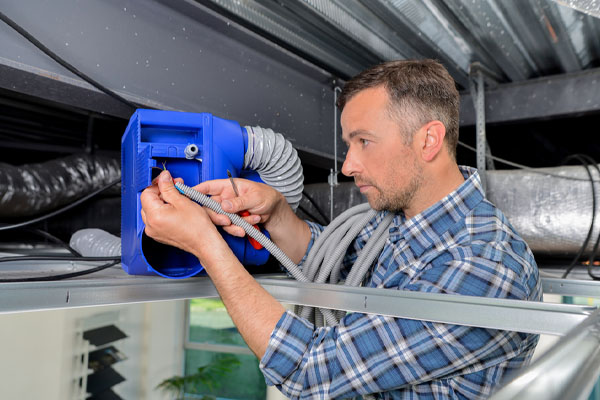Essential Role of Ductwork Design in HVAC Systems

Heating and cooling ductwork is crucial for maintaining indoor comfort and distributing conditioned air throughout a building. This article examines ductwork design’s importance in HVAC efficiency, including even airflow and temperature consistency. Understanding the impact of well-designed ductwork is key to a comfortable, energy-efficient living space. Read on for more in-depth ductwork design insights.
Understanding Ductwork Design
Contents
- 1 Understanding Ductwork Design
- 1.1 HVAC Ductwork: Energy Efficiency & Cost Savings
- 1.2 Proper HVAC Airflow & Comfort
- 1.3 Noise Reduction & HVAC Performance
- 1.4 Addressing Common Heating & Cooling Ductwork Issues
- 1.5 Practical Strategies to Improve Heating & AC Ductwork
- 1.6 Considerations for New Installations and Upgrades
- 1.7 Conclusion
- 2 Contact Townsend Energy for Your HVAC Needs
Comprehending the intricacies of ductwork design is about strategizing and constructing a network of conduits that transport warm or cool air throughout the structure. This process entails mapping out the duct layout, selecting appropriate sizes, and choosing the right duct materials.
Ensuring the ductwork is correctly sized and laid out is vital for effective air circulation. Inaccurate sizing can result in inadequate air movement or excessive energy consumption. A well-planned layout is crucial for even temperature distribution and minimizes pressure drops. Such optimization significantly boosts the efficiency and performance of the entire system.
The choice of materials for ductwork is a key factor in its functionality. Among the various materials available, the following are most frequently used:
- Flexible Ducts: They are known for their adaptability and ease of installation. However, they pose a risk of air leakage.
- Sheet Metal Ducts: Famed for their longevity and leak resistance, these require meticulous design and sealing for optimal performance.
Selecting the appropriate material is essential to achieve a harmonious balance of efficiency, durability, and cost-effectiveness in HVAC systems.
HVAC Ductwork: Energy Efficiency & Cost Savings
The design of HVAC ductwork is a critical component in realizing energy efficiency. Ducts that are designed effectively maintain balanced airflow and reduce energy loss, which can occur through leaks or poor insulation.
By ensuring that conditioned air is delivered efficiently to its intended areas, well-structured ducts contribute to lower utility bills. This efficient energy usage reduces costs and decreases the overall operating expenses of the system.
Ductwork that is correctly sealed and insulated leads to several benefits:
- Prevention of air leaks
- Minimized heat transfer
- Enhanced energy efficiency
- Maintains consistent temperatures indoors
- Improved overall performance of the HVAC system
- Elevates the comfort level
- Greater savings
Proper HVAC Airflow & Comfort

Effective ductwork design is essential for balanced HVAC airflow, ensuring even distribution of conditioned air, maintaining uniform temperatures, and preventing HVAC system strain. Optimal ducts eliminate hot and cold spots, enabling consistent comfort throughout a building, thereby increasing occupant satisfaction. Moreover, well-designed ductwork enhances indoor air quality by filtering and circulating air efficiently, reducing dust and contaminant buildup. This not only improves overall comfort but also positively affects occupant well-being, underscoring the importance of proficient ductwork design for both physical comfort and superior air quality.
Noise Reduction & HVAC Performance
The ductwork design significantly impacts the noise levels of HVAC systems, playing a crucial role in indoor environments’ overall comfort and serenity.
- Airflow Restrictions and Noise: Poorly designed ducts with sharp turns or small sizes can restrict airflow and increase noise. Smooth, well-sized ducts reduce turbulence and noise.
- Noise Transmission: Inadequately insulated or sealed ducts transmit HVAC noise to occupied spaces. Using proper insulation and sealing techniques helps dampen this noise.
- Duct Material and Thickness: Material choice influences noise levels; for example, thicker-walled ducts offer better noise insulation than thin, sheet metal ducts.
- Duct Placement and Distance: Thoughtful duct placement and increasing distance between HVAC equipment and occupied areas can minimize noise disturbance in quiet zones like bedrooms or offices.
- Acoustic Considerations: Integrating sound-absorbing materials and noise-reducing elements like silencers and baffles in ductwork design can proactively reduce noise transmission.
Minimizing noise in HVAC systems extends beyond just ensuring a quieter environment; it’s also integral to enhancing the system’s overall efficiency. Excessive noise can contribute to discomfort and increased stress, potentially leading to health concerns for the occupants. A system that operates quietly is often a sign of its proper functioning and optimal performance.
The design of ductwork directly influences the performance and efficiency of HVAC equipment. When ducts are poorly designed, they can restrict airflow, forcing the system to exert more effort to achieve the desired temperatures. This leads to higher energy consumption, reduced system efficiency, and undue strain and wear on various components.
Addressing Common Heating & Cooling Ductwork Issues
Common problems like leaks, insufficient insulation, and incorrect sizing can have significant adverse effects. Leaks in the ductwork waste energy, decrease the system’s efficiency and lead to inconsistent indoor temperatures. Inadequate insulation can result in unwanted heat loss or gain, directly affecting the comfort levels. Furthermore, incorrectly sized ducts can cause insufficient airflow, placing additional strain on the HVAC system.
Practical Strategies to Improve Heating & AC Ductwork
- Seal the ducts.
- Add insulation.
- Resize ducts to appropriately match with the system.
- Design ductwork with gradual bends, smooth transitions, and even air distribution.
Professional ductwork inspections and repairs are crucial. HVAC specialists are adept at identifying issues that may not be immediately apparent. They can assess the overall performance of the system and provide tailored solutions. Regular maintenance and prompt repairs are essential in keeping the ductwork efficient and trouble-free, contributing significantly to the longevity and optimal performance of the HVAC system.
Considerations for New Installations and Upgrades

For new constructions, the building layout, the size of each room, and the overall HVAC load are critical factors influencing the ductwork design. Ensuring proper sizing, layout, and selection of materials is essential to achieve an even distribution of airflow and efficient heating or cooling.
Upgrading existing duct systems includes thoroughly evaluating the current performance and identifying potential areas for improvement. Upgrades can encompass resizing ducts to better suit the system’s requirements, enhancing the insulation, or sealing any leaks to boost overall efficiency.
Working closely with HVAC professionals is crucial for attaining the best possible ductwork design. These experts have the skills to assess the specific needs of a building, calculate the necessary load requirements, and suggest design modifications or upgrades customized to the building’s unique attributes. Their professional expertise is invaluable in ensuring that new installations and system upgrades meet energy efficiency standards and deliver top-notch performance and efficiency.
Conclusion
Well-designed ductwork impacts HVAC efficiency, comfort, noise control, and longevity. The right layout, sizing, and materials are key to a harmonious indoor environment. Homeowners who focus on professional ductwork design can be confident that their HVAC systems will perform optimally, enhancing comfort, efficiency, and the overall well-being of occupants and the environment alike.
Contact Townsend Energy for Your HVAC Needs
Townsend Energy, a leading provider of heating and cooling services in Northeastern Massachusetts, Southern Maine, or Southern New Hampshire, boasts a team of professionally certified technicians. We specialize in HVAC maintenance, repairs, installations, and replacements, always ensuring top-quality service.
Understanding the need for a comfortable, energy-efficient home, Townsend Energy offers affordable services. Our maintenance enhances comfort and cuts energy costs. Whether you need repair or replacement, our technicians will recommend cost-effective solutions. We guarantee satisfaction with our work.
Call us to schedule a service appointment and receive a free, in-home estimate. Choose Townsend Energy for outstanding heating and cooling services that meet and exceed your expectations.
Contact us now at (800) 722-4101 to find out more! Click the link to view our service area.

Related Articles:
